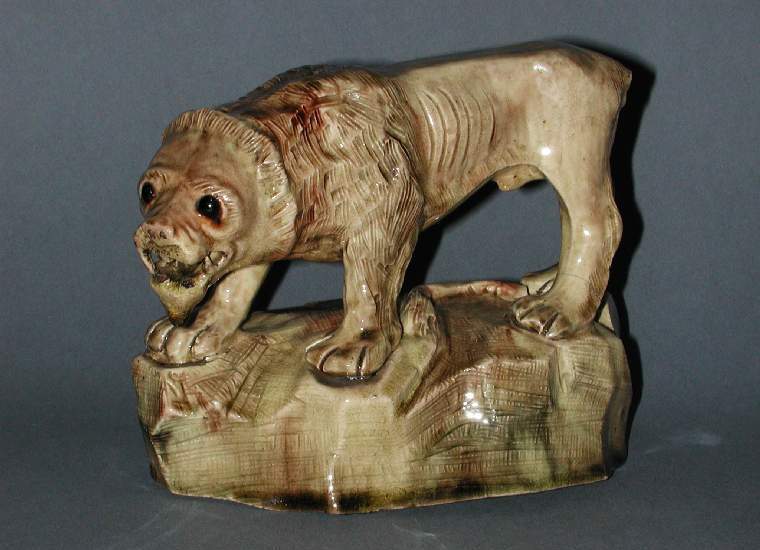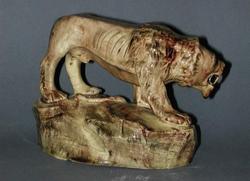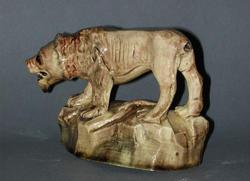Current Location: Gallery 27 (Glaisher)
Titles
Lion
Maker(s)
Production:
Unidentified factory
Entities
Categories
Description
Earthenware figure, moulded with modelled additions, coloured with oxides and lead glazed.
Cream earthenware figure of a lion standing on a rocky base. Moulding and incisions define features such as the mane, eyebrows, ribs and toes and green and brown colours, sponged underglaze, enhance the form. The eyes, coloured dark manganese brown, appear to heave been modeled separately and inserted.The base, a high mound, is hollow and glazed.
The underside is open and glazed.
Notes
History note: Bought from Miss Kingsland of Croydon on 9 June 1913, for £7, by Dr J.W.L. Glaisher, FRS, Trinity College, Cambridge.
Legal notes
Dr J. W. L. Glaisher Bequest, 1928
Measurements and weight
Height: 12.7 cm
Length: 17 cm
Width: 9.5 cm
Acquisition and important dates
Method of acquisition: Bequeathed
(1928-12-07)
by
Glaisher, J. W. L., Dr
Dating
18th Century, third quarter
Circa
1750
CE
-
Circa
1770
CE
Note
Rackham (1935) attributes this figure to Thomas Whieldon at Little Fenton. However, it is unmarked, and we now know that several other potters made figures at this time. Dr Glaisher, who called it a tiger, thought it ‘a very interesting piece of the pre-Whieldon period’ and noted he had seen another example.
This lion is a very early example of moulded earthenware animal figures made (mainly) in Staffordshire. The shaded colouring is produced by brown and green oxide colours under the glaze. A very similar example is found with clear glaze over the cream earthenware body and a brown coloured base and the existence of similarly modelled buffalos and elephants suggests that wild animals in general were a popular subject.
Components of the work
Decoration
composed of
high temperature colour
( manganese oxide)
lead-glaze
Parts
Materials used in production
cream and dark brown
Earthenware
Techniques used in production
Moulding
: Cream earthenware, moulded and modelled, and decorated with manganese-oxide under lead glaze
Inscription or legends present
- Text: 3694 pottery tiger with glaze being coloured. Interesting [\'85? before ] Ralph Wood. b. at Croydon, June 12, 1913
- Location: Underside of base
- Method of creation: Rectangular paper label handwritten in black ink
- Type: Label
References and bibliographic entries
Identification numbers
Accession number: C.835-1928
Primary reference Number: 76203
Old object number: 3694
Stable URI
Audit data
Created: Saturday 6 August 2011
Updated: Tuesday 30 April 2024
Last processed: Tuesday 15 July 2025
Associated departments & institutions
Owner or interested party:
The Fitzwilliam Museum
Associated department:
Applied Arts






